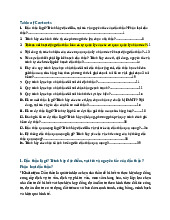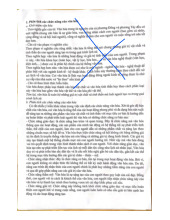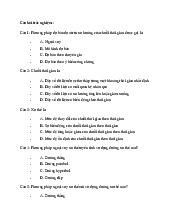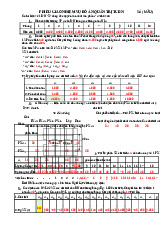









Preview text:
REVISION Format OF final test I. CHOOSE THE BEST ANSWER
1. (2m) Choose the best word to fill each gap
2. (2m) Circle the correct form of the word
3. (1m) Choose the best term to match the given definition II.
READ AND ANSWER QUESTIONS 6 QUESTONS (3m) III. TRANSLATION
1. Translate 2 sentences into Vietnamese (1m)
2. Translate 2 sentences into English (1m)
UNITS: 11, 12, 16, 18, 19
Translate the following sentences into Vietnamese 1.
Increase customer base – The size of market can be enlarged by marketing products
tooverseas buyers. This should lead to greater market share for the business. 2.
Economies of scale – By operating of larger scale, a business is likely to benefit from
costsavings known as economies of scale. 3.
Increase brand recognition – Having a standardized marketing strategy across the
world notonly reduces average cost of production, but can also lead to greater
international recognition of a brand. 4.
Spread risks – By operating in various countries, a business is less exposed to the
risks in oneparticular country (such as a recession or changes in fashion). 5.
Managers can plan to steer the organization in the best possible direction, taking
into consideration the organization’s internal strengths and weaknesses. 6.
Good managers understand that although they are leading the organization in a
predetermined direction, they should anticipate change in the environment, and adjust
their goals and plans accordingly when necessary. 7.
Cash flow budget is an estimate of all cash receipts and all cash expenditures that
areexpected to occur during a certain time period. Estimates can be made monthly, bimonthly, or quarterly. 8.
An expansion plan requiring new outside investment would include full
companydescriptions and background on the management team, just the same as a
standard plan for investors would. 9.
Organizational behavior (OB) is the study of the way individuals interact within
organizations,normally, this study is applied in an attempt to create more efficient business organizations. 10.
In order to achieve the desired results, managers may adopt different tactics,
includingreorganizing groups, modifying compensation structures and changing the way performance is evaluated. 11.
Communication is an essential element of leading. Effective leadership depends on
constantcommunication between leaders and their employees. 12.
Good communication is to good relations between managers and individual
employees, groups, teams and, ultimately, the organization and its environment. 13.
A considerable proportion of a manager’s time is devoted to communicating with
theorganization’s stakeholders, both inside and outside of the organization. 14.
A simple communication model is a process, which provides a basis for
understanding thekey elements of interpersonal communication: sender → massage → channel → receiver. 15.
The sender should take care with his/her choice of words and their meaning, and
should encourage two-way communication by showing insight into the receiver’s perceptions. 16.
Flexible structures are also likely to be found in task cultures where the focus is on
using the talents of team members, often from different department, to achieve organizational objectives. 17.
There are many ways that managers can encourage a sense of responsibility, from
creatingopportunities to work in enter-departmental teams to organizing social events for
people to get to know each other better. 18.
It cannot be said that one culture is better than another, only that a culture is to a
greateror lesser extent appropriate in the sense of being relevant to the needs and
circumstances of the organization and helping rather than hindering its performance. 19.
Employees have to know clearly what they will be held accountable for and be given
every opportunity to use their abilities in achieving objectives that they have agreed and are committed to. 20.
Extend the product life cycle – A business might find that the domestic market for
its product in saturated or in decline. By marketing the product overseas, the firm can
expand its life cycle to generate higher revenues. MULTIPLE CHOICE
I. Choose the best word to fill in each gap 1.
Global marketing, an extension of international marketing, refers to selling a product using the
same marketing........ throughout the world. a. path b. approach c. attack d. overture 2.
The business operating in the domestic country sells its products directly to an overseas buyer
by................ The advantage of this is that it eliminates the need to set up a business abroad A. exporting b. direct investment c. franchising d. mergers
3. Branding can be a very........tool in marketing a product overseas. Scientists, psychologists and
economists have all produced evidence to show that branding can have a huge effect on the buying decisions made by consumers. A. careful b. powerful c. power d. useless
4. Smaller firms therefore need to ensure that their international marketing strategy is very
carefully researched and planned ........ failure overseas can be fatten to the business. A. since b. so c. however d. therefore
5. International marketing is based on an extension of a company’s local marketing....... With special
attention paid to identification, targeting, and decisions internationally. a. role b. strategy c. rule d. Plan
6. The previous review of the business plan and its ........ will help highlight which areas of the business
have proved difficult to forecast historically. a. income b. approach c. outcome d. overcome
7. This one-year plan, or budget, will be prepared in such a way that progress can be regularly monitored
by checking the ........ between the actual performance and the budget, which will be phased to take
account of seasonal variations. a. variance b. invariance c. division d. outgone
8. The cash flow ......... is usually considered to be the most important part of your financial planning and
is a no-brainer for inclusion in the plan. a. command b. power c. statement d. situation
9. This kind of no-frills plan is good for deciding whether or not to proceed with an idea, to help gauge
whether this is a business .... ... pursuing. a. worthless
b. cost c. worth d. instruction
10. The business plan has to be a living document, constantly in use to monitor, ......... and guide the progress of a business. a. role b. master c. rule d. control
11. Specialists within different areas of management and business are inevitably working with …….. on
whose cooperation and “good behavior” they depend. a. others b. the others c. another d. other
12. First-line supervisors spend far ……. time on conceptual and human work. A. less b. much c. little d. many
13. It is, rather an……………… of how in contemporary, materialistic societies, the individual A. affect b. effect c. afford d. effort
14. The component concerned with the development of new systems and methods of operation is………… the conceptual component c. the human component the
technical component d. the financial component
15. Human resource management takes the ………………….. and principles studied in OB and explores the
“nuts- and-bolts” applications of those principles in organizations. a. rules b. strategies c. theories d. Plans
16. Leadership is not the only …… of organizational success, it is one of the most important variables influencing this success. a. ingredient b. member c. part d. change
17. In order to manage employees effectively, managers should understand what motivates the behavior of their
…….. This is a crucial aspect of the leading function
a. employees b. employers c. colleagues d. leaders
18. The motivation process starts with an unsatisfied need and moves in a certain ……. For example, an
employeehas an unsatisfied need for higher status in the organizations a. Scenes
b. succession c. satisfaction d. sequence
19. Effective managers understand that employees must process a high level of motivation plus the
appropriate training, knowledge and skills to perform …………. in a given work situation. a. fully b. responsible c.affectively d. effectively
20. The consequence of the behaviour might be that she receives a promotion (or does not receive a
promotion), which will lead to the ………………… (or dissatisfaction) of her need.
a. need b. satisfaction c. unsatisfaction d. Control
21. Business planning is an important document for discussion with prospective ………… and lenders of finance. A. leaders B. Managers C. Inventors D. investors
22. A business plan has to be particular to the organization in question, its situation and time. However, a
business plan is not just a…………, to be produced and filed. Business planning is a continuous process. A. document B. Papers C. Text D. book
23. The findings from those research studies are then ……………………. by managers or consultants to see
whether they help meet “real-world” challenges. A. controlled B. Estimated C. Approved D. applied
24.……………………………focuses on the product choices and industry characteristics that affect an
organization’s profitability. A. Strategic Management B. Human Resource Management C. Marketing Management D. Inventory Management
25. Management is that managers responsible for getting things done, usually through other people or
the process of realizing organizational ……… through people and other resources. A. production B. ManagementC. Objectives D. results
27. Culture can help people to ‘fit in’ based on the organization’s traditions and ……………………. A. decisions B. Regulations C. Structures D. routines
28. Understanding the culture of a department or an organization is important to any manager who
wishes to effectively implement ………………… in the business. A. strategy B. Plans C. Change D. objectives
29. In reality, ……………... one culture might dominate in a particular organization, there may be other
groups that conform to subcultures. A. because B. So C. Although D. When
30. Firms that encourage a total quality culture need to invest in the ……………. and development of their staff. A. changing B. training C. directing D. working
II. Circle the correct form of the word 1.
Dell then markets their computers with an ......... emphasis on customer needs and
customization-unlike other companies that sell pre-manufactured products.
a. exceptional b. exceptionable c. exception d. Exceptionality 2.
Companies ....... goods that have customs restrictions, like food and live plants, must contend
with a more rigorous regulatory process before marketing their products internationally. A. sale b. selling c. sell d. sold 3.
Businesses that are able to adopt global marketing strategies benefit from being able ........ a
single product in exactly the same way throughout the world. a. marketing b. to market c. market d. Marketable 4.
Organizations made up of highly skilled and ………………… staff have a different culture from those
with demotivated staff who have no input in decision making. A. demotivated B. motivated C. demotivation D. motivation
5. The Small Business Administration states, “ The development of a...... business plan shows whether or
not a business has the potential to make a profit” A. comprehension
b. comprehensiveness c. comprehensive d. comprehensible
6. A standard business plan will start with an executive summary ....... the key points of your plan, and
end with appendices showing monthly projections for the first year. a. describe b. describing c. described d. to describe
7. A human component is the component that concerns the workforce and ………………. well- being. a. employer b. employment c. employ d. employee
8. Organizational behavior is the study and ……….. of sociology, psychology, communication and
management of the individuals in an organization. A. applicant b.appliance c. application d. applying
9. By its nature, operational ……. examines how the firm performs in relation to its own standards and to its rivals’ standards. a. effect b. effective c. effectiveness d. effectively 10.
Communication is an essential element of leading. Effective leadership depends on
constant………………… between leaders and their employees.
a. communicantb. communicability
c. communication d. communicativeness 11.
Good communication is …………. to good relations between managers and individual employees,
groups, teams and, ultimately, the organization and its environment.comprehension a. conducive
b. conductive c. conductance d. conduct 12.
A …………………….. proportion of a manager’s time is devoted to communicating with the
organization s ‟ stakeholders, both inside and outside the organization. a. considerable b. consider
c. considerably d. Consideration 13.
A strong and positive culture is more likely to prevail if there are ……… systems to reward
and recognize the efforts of workers. a. establish b. establishing c. established d. establishment
14. Large and well-established organizations create a sense of belonging by developing …… accounts of their businesses. a. historical b. historically c. history d. historicist
15. If employees are appropriately remunerated for their efforts, the organization is more likely to
develop a strong ………………. culture. A. unity B. unitedly C. united D. unite
16. Franchising involves a business ………………..others to trade under its name in return for a fee and a
share of revenues. McDonald’s, KFC, Pizza Hut and Burger King use this growth strategy to market their product overseas. A. allowed B. Allowance C. Allowing D. to allow
17. Alternatively, business may use licensing where buy another firm buys the right to produce the goods
of the business. Nike licenses the ………………….. of their sports shoes and sportswear to business in Indonesia. A. product B. Productive C. Productivity D. production
18. Mergers take place when two businesses agree to integrate as a single organization. ………………………
with a foreign company can help businesses to gain access to overseas markets. A. Merging B. Merge C. Merged D. To merge
19. Internal plans are not intended for banks, outside ………………………. or other third parties. A. investing B. Investors C. Investment D. invest
20. An operation plan includes specific ………………………. milestones, project deadlines, and responsibilities of team members and managers. A. implement B. Implementing C. Implementation D. implemented
21. A ..………………………. or expansion plan focuses on a specific area of a business, or a subset of the business. A. growing B. Grow C. Grown D. growth
22. An expansion plan requiring new outside investment would include full company …………………………….
and background on the management team, just the same as a standard plan for investors would. A. descriptions B. Descriptive C. Describer D. describing
23. Loan ……………………… would require full company descriptions and background on the management team much detail as well. A. appliers B. Applications C. Applicant D. apply
24. Top ………………... spend the bulk of their time engaged in conceptual and human work. A. executors B. Executing C. Executives D. executive
25. Motivation can be described as the internal force that impacts the direction, intensity, and endurance
of a person’s ……………………. choice of behavior. A. volunteer B. Voluntary C. Voluntarism D. voluntarily
26. If the managers understand what ……………………………. the behaviour of their employees, they can
influence the employees’ work performance. A. motivates B. to motivate C. Motivating D. motivated
27. The authority relations created in …………………….. relate strongly to the leading function of managers
as the leading function gives managers the right to use authority, power, responsibility, delegation. A. organize B. Organizations C. Organizing D. organized
28. Without power, a manager would not be able to influence employees sufficiently towards
……………………… organizational goals. A. achievement B. Achievable C. Achieving D. achieve
29. Influencing is the process leaders follow when communicating ideas, gaining ……………………….. of
them, and inspiring followers to support and implement the ideas through change. A. acceptation B. Acceptability C. Acceptable D. acceptance
30. Managers delegate …………………………….. and authority down the chain of command. Delegation refers
to giving employees new tasks. A. responsibility B. Responsible C. Response D. responsory
III. Choose the best term to match the given definition
1. It refers to the use of telephone systems (audio and text messaging) to sell products directly to potential customers. a. E-commerce b. Exporting c. Telemarketing d. Retailer
2. It refers to the mannerism in which business is conducted. It varies from one country to another so
marketers must be aware of the different protocols that exist. a. Business culture
b. Business etiquette c. Communication d. Exporting
3. An estimate of an expenditure made before the appropriation. a. Forecast b. Strategy c. Forecast out-turn d. Figure
4. It is an elaborate and systematic plan of action or a method or a plan chosen to bring about a desired
future, such as achievement of a goal or solution to a problem. a. Analysis b. Strategy c. Communication d. Program
5. The degree to which an employee is committed to their company based on the influence of other people in the firm. Affective commitment c. Continuance commitment Normative commitment d. Effective commitment
6. The process of evaluating two or more options in order to reach the best possible outcome. a. planning b. evaluating c. consulting d. decision making
9. It refers to the difference between existing culture in an organization and its desired culture. a. Culture Shock b. Culture Conflict c. Culture Gap d. Culture Code
10. It exists in an organization when staff in similar positions, with similar expertise and training form
groups to share their knowledge. a. Power Culture b. Role Culture c. Task Culture d. Person Culture
11. The sellers of products to the general public (i.e. consumers) that operate in outlets. A. Marketers B. Customers C. Sellers D. Retailers
12. This is a sum of money allocated for a particular purpose or an estimate of costs, revenues, and
resources over a specified period, reflecting a reading of future financial conditions and goals. A. Budget B. Fund C. Strategy D. Cash
13. This is the aggregation of all lower-level budgets produced by a company's various functional areas,
and includes budgeted financial statements, a cash forecast, and a financing plan. A. Master budget B. Cash flow budget C. Budget D. Forecast out-turn
14. It is an acronym for strengths, weaknesses, opportunities, and threats and is a structured planning
method that evaluates those four elements of an organization, project or business venture. This analysis
can be carried out for a company, product, place, industry, or person. A. ROI analysis
B. TNA analysis C. PEST analysis D. SWOT analysis 15.
A corporate value system which recognizes that normal business rules and pressures don't apply to innovative thinking. A. Breakthrough culture B. High context culture C. Low context culture D. Consumer culture 16.
A very general belief about what other people are like (e.g, untrustworthy) that has wide effect
on our perceptions of others behavior. A. Personal opinions B. Personal assessments C. Personal feelings D. Personal constructs
17. Ascribing/assigning the cause of a person's behavior at work to something about them (e.g, their
effort, their innate ability, etc.). A. Internal contribution B. Internal attribution C. External contribution D. External attribution
18. A process that arouses and channels employee effort and behavior toward achieving goals. A. Motivation B. Performance C. Satisfaction D. Interaction
26. This refers to a business setting up production and/ or distribution facilities overseas. A company of
this kind places a fixed asset in a foreign country with the aim of manufacturing a product, or part of a product, abroad. A. Direct investment B. Joint venture C. Merge D. Franchising
27. This is the application of marketing principles in more than one country, by companies overseas or
across national borders. It is based on an extension of a company’s local marketing strategy, with special
attention paid to marketing identification, targeting, and decisions internationally. A. Marketing mix B. International marketing C. Local marketing D. Global marketing
28. A person or institution that hires employees or workers. He/ She offers wages or a salary to the
workers in exchange for the worker's work or labor. A. Administration B. Constitution C. Organization D. Governance
29. Administering a positive consequence (e.g., praise) to strengthen a positive behavior. A. Negative reinforcement B. Negative punishment C. Positive reinforcement D. Positive punishment
30. A set of training and information dissemination programs that help employees recognize the value of differences among people. A. Training programs B. Inclusion programs C. Professional programs D. Diversity programs



